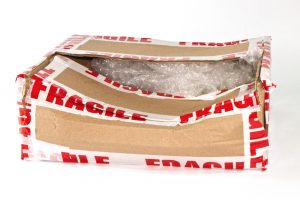Disclaimer: The following consequences of poor packaging are entirely preventable.
If your number one priority is shipping products as quickly as possible, and by any means necessary, stop reading. If you are not concerned with the quality of the product as it arrives to your customer, this article is not for you. The condition of a product when it arrives at its destination matters (a lot) to your business. Your product is only as good as the materials used to ship it. What is the real cost of poor packaging?
Damaged Packaging
There are many reasons why packages are damaged during shipping. One glaring issue is the way products are handled during shipment. According to George Yarusavage, CTL, C.P.M., and Principal in Fortress Consulting, in his article for Parcel, “Assume that whatever you ship via any carrier will be tossed, kicked, dropped, shoved, stacked, and generally roughed up.” This is hard for any business to control.
For argument’s sake, let’s consider this treatment of packaging a constant and the problem out of your hands. Damaged packaging is still preventable even when the package is not handled with care. Here are some common reasons why damage happens during packaging, and their real cost to your business.
1. Cheap Materials
This is an easy problem to have if you are focused on the cost of materials. Many purchasers look for the most competitively priced items in order to save money. Getting the price down on materials, even if only by pennies per unit, feels good in the short term and looks good on paper.
The real cost: Torn and deteriorated packaging compromises the product, increasing damage claims and returns. Now, instead of spending a few dollars more on quality packaging, you are hit with new turnaround and processing fees and labor time. Your business reputation will also take a hit as more customers become angry and unsatisfied with their products.
2. Packaging that is too big or too small
Most people aren’t packaging experts, so they don’t always know the best fit for shipping certain products. Some of our case studies explain the importance of understanding a product’s shipping needs, i.e. perishable goods or fragile materials. Packaging depends on the product, and it’s important to use the correct size packaging for shipping goods.
The real cost: Wrong-sized packaging causes goods to break, leak, or crush during shipment, again increasing damage claims, costs, and unhappy customers.
3. Improper protection
Peanuts and bubble wrap used to be the only forms of package protection. Protection, commonly known as void fill, has come a L O N G way in terms of packaging engineering. Products like air pillows, partitions, and sustainable paper fill have taken over as some of the best ways to protect goods during shipment. Like problem #2 above, the issue that many businesses face is lack of packaging expertise and/or the desire to save money on product. Purchasers may defer to peanuts because it’s cheaper and what they are familiar with.
The real cost: Excess and unnecessary void fill increases environmental and product damage, and costs businesses more money than what was originally saved using the incorrect or cheaper product.
Consider these costs the next time you reach for the cheapest product on the market. Product damage is preventable and easy to avoid, even when some factors are out of your control.
